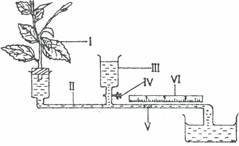Study the diagram below and use it to answer questions l(a) to l(e)

(i) Identify the instrument in the diagram
…………………………………………........................................................................................... [1 mark ]
Name the parts labelled I to VI:
I…………………………………………… IV……………………………………
II. ………………………………………… V.…………………………………
III. ………………………………………… VI.………………………………… [ 3 marks]
(b)
(i) Outline the process for taking readings with the instrument.
………………………………………………………………………………… …
…………………………………………………………………………………… [7 marks]
(ii) State two precautions necessary to get correct readings in the experimental set-up .
…………………………………………………………………………………
………………………………………………………………………………………………………………………………….[2 marks]
(c) (i) What is the limitation of using this instrument?
………………………………………………………………………… ……. [ 2 mark]
(ii) State two other methods that can be used to measure the process taking place in the
part labelled I in the diagram.
………………………………………………………………………………………………………………………………………….
…………………………………………………………………………………………………………………………………………
……………………………………………………………………………………………………………………………………….. [ 2 marks]
(d)
List four factors that can affect the process being measured
………………………………………………………………………………………………………………………………………..
………………………………………………………………………………………………………………………………………..
………………………………………………………………………………………………………………………………………..
………………………………………………………………………………………………………………………………………..
………………………………………………………………………………………………………………………………………..[ 4 mark]
(e)
State the importance of the process being measured in nature.
………………………………………………………………………………………………………………………………………….
…………………………………………………………………………………………………………………………………………. [4 marks]



